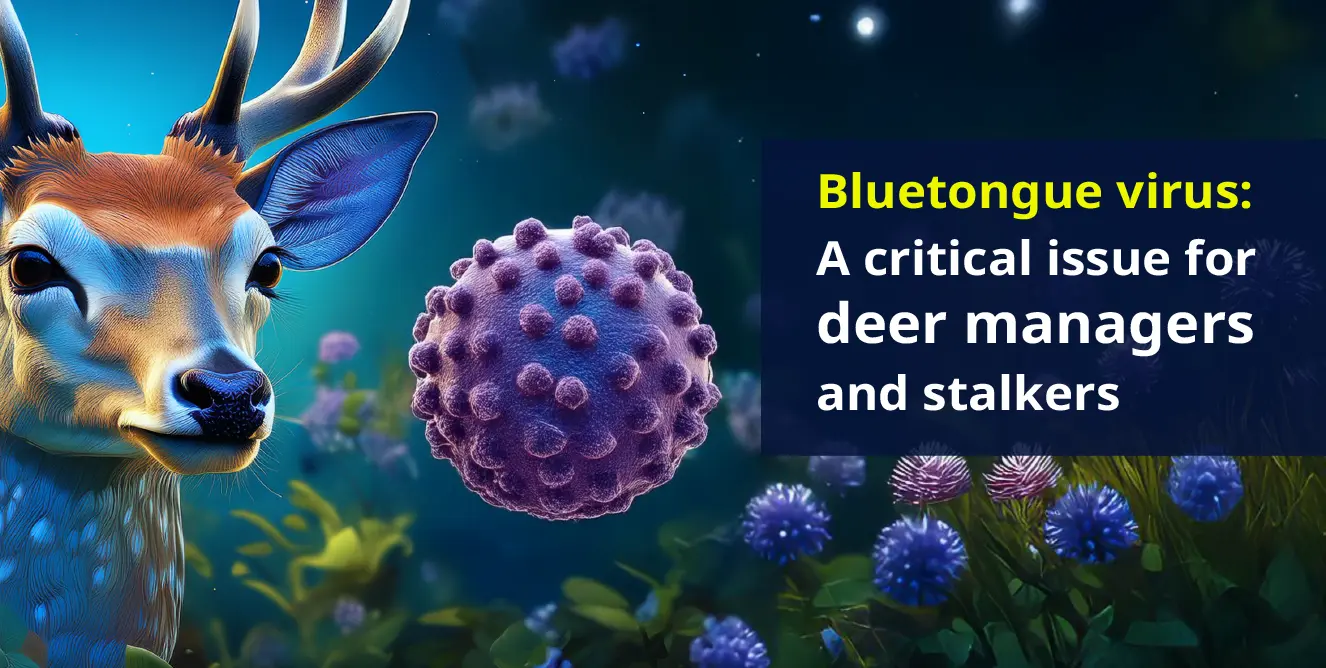Bluetongue virus: A critical issue for deer managers and stalkers
15-Nov-2024

Mark Eves
With growing concerns over wildlife diseases, Bluetongue virus (BTV) has emerged as a significant threat to deer populations in the UK. Although typically associated with livestock, the virus poses serious risks to wild ruminants such as deer. For deer managers and stalkers, understanding Bluetongue and its potential impact is crucial in maintaining healthy deer populations and ensuring sustainable management practices.
What exactly is the bluetongue virus?
Bluetongue virus is transmitted by midges and primarily affects ruminants, including both livestock and wild species. Though deer are not the virus’s primary target, they can still become infected, potentially suffering from severe symptoms. The virus causes a range of clinical signs, including fever, swelling around the head, and difficulty breathing. In some cases, infected animals may exhibit no visible symptoms, making it challenging to detect outbreaks early.
One important thing to note is that Bluetongue is not contagious between animals—midges are the only means of transmission. However, the presence of infected midges in an area can quickly spread the virus among deer and other animals. Although Bluetongue does not affect humans, its impact on wildlife and livestock is enough to cause concern for deer managers, stalkers, and conservationists.
Can it affect humans?
Bluetongue virus (BTV) does not pose any direct danger to humans. It is a disease that primarily affects ruminant animals, such as cattle, sheep, and wild species like deer. Humans cannot contract Bluetongue from infected animals, through handling them, or by consuming meat or milk from infected livestock.
However, there are indirect dangers and concerns related to Bluetongue that can affect humans, particularly those involved in wildlife management, agriculture, and rural economies:
Economic impact: An outbreak of Bluetongue can significantly affect farming and rural livelihoods, particularly in sectors like livestock farming and deer management. Restrictions on the movement of animals, quarantine measures, and a drop in livestock productivity can result in financial losses for farmers and related industries.
Impact on rural communities: Deer management and stalking are important activities in many rural areas, supporting local economies through tourism, venison production, and land management. A widespread outbreak affecting deer populations could reduce these opportunities, with a ripple effect on local jobs and revenue streams.
Ecological consequences: Bluetongue's impact on deer populations and other wildlife can have ecological consequences, which may indirectly affect humans. Disruptions in deer populations can lead to imbalances in vegetation, which may impact forestry, conservation projects, and other land-use practices. This, in turn, can affect the way ecosystems function and how humans interact with these environments.
While the virus itself is not harmful to humans, the secondary effects on economies, ecosystems, and communities highlight the importance of disease management and monitoring to mitigate these broader risks.
Why deer managers should be prepared?
Deer are an integral part of the UK’s biodiversity, playing a key role in the health of ecosystems. Deer management is not only essential for wildlife conservation but also supports rural economies through industries such as stalking, venison production, and ecotourism. A Bluetongue outbreak could affect all of these activities, leading to economic setbacks and population declines in certain species.
A drop in deer numbers due to disease could also lead to ecological imbalances, such as unchecked plant growth, changes in predator-prey dynamics, and altered habitats for other species. Preventing the spread of Bluetongue is therefore not just about protecting deer; it’s about maintaining the balance of the ecosystems they inhabit.
Proactive measures for deer managers and stalkers
Managing deer in a time of disease threats requires a combination of vigilance, preventive action, and cooperation with authorities. Here are some essential steps that deer managers and stalkers can take:
1. Regular herd monitoring: Watch for signs of illness in deer, particularly during peak midge activity periods (typically late summer to autumn). Be alert to any unusual behaviour or physical symptoms such as swelling, difficulty breathing, or lethargy.
2. Use of repellents and environmental management: One effective way to reduce the risk of Bluetongue transmission is by minimising exposure to biting midges. Using insect repellents or keeping deer away from midge-heavy areas like wetlands can help. Additionally, managing water sources to reduce midge breeding grounds is another practical step.
3. Biosecurity practices: Cleaning equipment, clothing, and vehicles regularly can help prevent cross-contamination when moving between different sites. Ensuring that proper hygiene is maintained will help minimise the chances of spreading the virus.
4. Stay updated on vaccination policies: Although there is no vaccine for deer, vaccinations for livestock are available in some regions during outbreaks. Keeping an eye on local policies regarding Bluetongue vaccination in livestock can provide insights into the severity of outbreaks and help inform decisions on whether additional measures should be taken for deer populations.
5. Collaborate with the wider community: Cooperation is key in managing disease outbreaks. Deer managers should work closely with local farmers, wildlife groups, and veterinary services to share information about disease risks and mitigation strategies. Keeping communication channels open will help ensure timely responses if an outbreak occurs.
Climate and the future threat of bluetongue
As the climate continues to warm, the geographic range of midges that carry Bluetongue may expand, bringing the virus into areas previously unaffected. Deer managers will need to stay proactive in monitoring environmental changes and understanding how shifting weather patterns may influence the spread of the virus.
In the coming years, greater collaboration between conservation groups, government agencies, and the deer management community will be vital in combating the potential risks posed by Bluetongue and other emerging diseases.
The importance of preparedness
Bluetongue is not yet widespread in the UK’s deer populations, but the potential risks cannot be ignored. Being well-prepared, informed, and proactive can make all the difference in protecting deer and maintaining healthy ecosystems. For deer managers and stalkers, staying vigilant and implementing effective disease prevention measures are essential steps in safeguarding the future of deer in the UK.
For more detailed guidance on disease management in deer populations, including up-to-date information on Bluetongue, deer managers should consider reaching out to professional organisations like the British Deer Society.
Must read:
